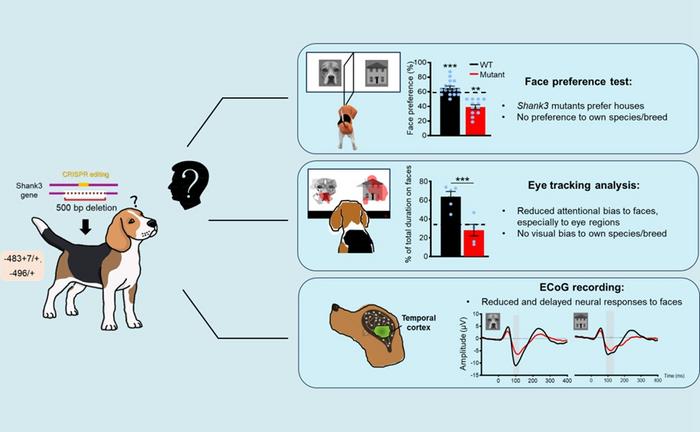In a groundbreaking study, researchers have unveiled that Beagle dogs possessing mutations in the Shank3 gene—a gene widely recognized as a significant risk factor for autism spectrum disorder (ASD)—exhibit remarkable parallels in face processing abnormalities that mirror those documented in human ASD patients. This fascinating research contributes to a growing body of evidence linking genetics with behavioral manifestations of ASD, providing new insights into the mechanisms that may underpin social deficits in both dogs and humans.
Published in the esteemed journal Science Advances on April 3, the study is the brainchild of a collaborative effort spearheaded by Professor Zhang Yongqing from the Institute of Genetics and Developmental Biology at the Chinese Academy of Sciences, alongside Professor Han Shihui from Peking University. Their investigation into the Shank3 mutant Beagle dogs presents an innovative experimental framework that could significantly advance our understanding of neurodevelopmental disorders.
Autism is not merely a single condition but a complex spectrum of neurodevelopmental disorders characterized by a myriad of social impairments, communication challenges, and the presence of repetitive behaviors. Essential to human social interactions is the intricate ability to process facial cues accurately. Impairments in this capacity have been linked to the social challenges faced by individuals on the autism spectrum. Despite the identification of numerous risk genes associated with autism, it remains uncertain whether specific genetic mutations can lead directly to such cognitive impairments.
This study meticulously crafted a face-based social preference test, aimed at gauging the face recognition skills of Shank3 mutant dogs in comparison to their genetically normal (wild-type) counterparts. The outcomes were striking; the mutant dogs displayed a diminished preference for facial stimuli, showing a clear absence of the instinctual attraction toward conspecific faces—faces belonging to their own species. These findings suggest that the Shank3 mutation is linked to profound deficits in social behaviors that revolve around face recognition, evident in both canine and human subjects.
Alongside behavioral assessments, the research team applied cutting-edge eye-tracking technology to analyze the visual attention these dogs allocated to human faces. Results indicated that the Shank3 mutant Beagles exhibited a significant reduction in their gaze directed at faces, particularly in the eye region, which is crucial for social signaling and communication. Such observations underscore the implications of genetic mutations in altering critical aspects of social cognition.
To delve deeper into the neurological underpinnings of these behavioral abnormalities, the researchers utilized electrocorticography (ECoG) to measure the brain activity of the dogs during face processing tasks. Their findings revealed that Shank3 mutant dogs displayed both a marked decrease in the amplitude of the face-specific N1 brainwave component and a delayed response when exposed to facial stimuli. This brainwave, typically observed approximately 100 milliseconds post-stimulation, is indicative of the neural mechanisms involved in face perception.
Further investigations took shape in the form of categorization tasks wherein the dogs were required to differentiate between various facial types—encompassing different species and breeds—through a method known as the repetition suppression paradigm, commonly employed in human studies to investigate cognitive processing. Wild-type dogs successfully distinguished between these facial categories, demonstrating an intuitive response pattern to the faces of other species followed by a delayed reaction to conspecific faces. In stark contrast, Shank3 mutant dogs exhibited significant challenges in categorizing faces appropriately, further elucidating the connection between genetic mutations and cognitive deficiencies.
This pioneering study delivers compelling, empirical evidence supporting the notion that mutations in the Shank3 gene culminate in ASD-like deficits in face processing. The implications of these findings extend beyond the realm of canine cognition; they pave the way for novel experimental approaches in understanding the genetic and neural paradigms associated with autism. Establishing canines as a model for studying ASD not only enriches our comprehension of the disorder but also opens avenues for exploring potential therapeutic interventions.
In addition to providing insights into the behavioral challenges faced by both dogs and humans, such research can foster a deeper societal understanding of autism. By drawing connections between genetic factors and the manifestation of social behavior irregularities, the findings may resonate with families and practitioners dealing with ASD, potentially steering future research and therapeutic strategies towards ameliorating these complex conditions.
Moreover, the implications of employing canine models in this context underscore the utility of pets in scientific exploration. The innate social nature of dogs allows researchers to tap into behavioral paradigms that are more challenging to study in human populations, thereby shedding light on the undercurrents of autism and social cognition. This focus on a familiar species not only bridges the gap between genetics and behavior but also fosters a more comprehensive discourse on neurodevelopmental disorders that affect diverse populations.
As we move forward, the question remains: how can this research inform practical applications in understanding and addressing ASD in humans? One possibility lies in the exploration of shared pathways that govern social cognition. If certain genetic markers found within canines can translate to human cases, there may be untapped potential for developing intervention strategies that focus on enhancing social interactions and communication skills.
Thus, the work of Zhang and his colleagues not only amplifies our understanding of autism’s genetic components but also invites further exploration into the intersection of genetic research, animal behavior, and effective therapeutic interventions in the human population. As studies like this gain traction, we may soon see the contours of a more informed paradigm emerge—one that holistically synthesizes genetic, behavioral, and therapeutic elements in addressing the complexities of autism spectrum disorder.
Subject of Research: Genetics and neuroscience of autism as reflected in canine models.
Article Title: Autism-like atypical face processing in Shank3 mutant dogs.
News Publication Date: April 3, 2025.
Web References: Science Advances.
References: Evidence from experimental studies utilizing canine models to understand face processing and social behavior in autism.
Image Credits: IGDB
Keywords: Autism, Shank3 mutation, face processing, social behavior, neurodevelopmental disorders, canine models, genetic research, experimental study, behavioral genetics, eye-tracking technology, electrocorticography, cognitive function.




